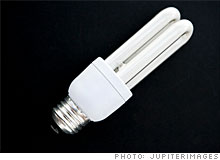The fluorescent light bulb boogeyman
Experts say the super efficient bulbs - soon to dominate store shelves - are plenty safe. But skeptics remain.
 |
| Experts say they're safe, but skeptics remain. |
NEW YORK (CNNMoney.com) -- So now the government's going to tell you what light bulb to buy, and it could be hazardous to your health.
That was the takeaway from some conservative and libertarian-minded folks when the energy bill of 2007 mandated more efficient lighting that would lead to a gradual phase out of many incandescent bulbs. Europe's ban began this week and the new U.S. rules take effect in 2012.
The concept of the government dictating light bulbs seemed too juicy for some groups to pass up. The fact that the more efficient fluorescent bulbs contain mercury - a highly toxic element - gave actual grounds for objection.
But environmentalists point out that the increased electricity required to run a regular lightbulb from a powerplant produces a lot of mercury too.
Nonetheless, criticism of fluorescent bulbs was fast and furious.
"Everyone is being urged, cajoled and guilt-tripped into [replacing] Thomas Edison's incandescents," wrote the WorldNetDaily, a news Web site that bills itself as "a free press for a free people." "However, there is no problem disposing of incandescents...you can throw them in the trash can and they won't hurt the garbage collector...they won't kill people working in the landfills."
The poster-child for the anti-fluorescent bulbers is Brandy Bridges, a mother in Maine who broke a bulb in her daughter's bedroom a couple years back.
Bridges, aware the bulbs contained mercury, called state officials, who came over, did tests, and told her to have the room cleaned by a hazardous waste crew - to the tune of over $2,000. Maine officials eventually came to her house and cut out the carpet.
This story has been widely circulated on the Internet, and sharp criticism of the government mandate continues today from email chain letters to rants on Capitol Hill.
The mandate, which doesn't ban incandescent bulbs but requires much greater efficiency that will effectively take most of them off the shelf, phases in starting in 2012. One in Europe began earlier this week.
But much of the fear surrounding fluorescent light bulbs may be overblown.
When contacted about the Bridges case, Maine officials said the advice to get a professional hazardous waste cleaner and remove the carpet was given before a policy on fluorescents was fully developed. They no longer tell people to call a hazmat crew or remove rugs, unless the homeowner is particularly concerned.
Maine regulators, along with national environmental groups, consumer advocates and the federal government, all still recommend using the energy-saving bulbs.
When it comes to safety, they say the amount of mercury in a fluorescent bulb is so small it should not present a health risk. According to the Environmental Protection Agency, the average fluorescent light bulb contains about 4 milligrams of mercury, over 100 times less than found in an old mercury thermometer.
Consumer Reports just did extensive testing of the bulbs and found that many contain even less mercury - some had just 1 milligram.
"It's not something to panic about," said Celia Kuperszmid Lehrman, deputy home editor at Consumer Reports. "Tube fluorescents like we all have in our offices and schools have mercury too, and it's not like they evacuate a school every time a bulb breaks."
Still, the bulbs should be handled with care if broken. EPA recommends several steps including cleaning up the glass with cardboard or another item that can be disposed of after, opening the window, and putting the remnants in an outside garbage can.
If your town collects other household hazardous waste like batteries, paint or cleaning supplies, then you should dispose of the bulbs in the same manner. Home Depot and Ikea will recycle any old fluorescent bulbs, no mater where they were purchased.
Also, if the light is close to small children or pets that may easily knock it over, it's probably best to use another type of bulb. Efficient, mercury-free incandescents like halogen lights, as well as LED lights will still be available after the new efficiency standards kick in.
The benefits of using fluorescent bulbs, experts say, far outweighs any mercury risk.
When it comes to mercury content, a fluorescent bulb ends up putting far less mercury into the environment compared to all the extra electricity required to run an inefficient bulb - four times less mercury, according to Noah Horowitz of the Natural Resources Defense Council.
If the whole country switched to fluorescents, says Horowitz, it would eliminate the need to build 30 new coal power plants and save as much electricity as used by all the homes in Texas.
Then there's the cost savings. Consumer reports estimates that each incandescent replaced with a $1.50 fluorescent will save an individual $56 in electricity costs over the life of the bulb.
"You'd be hard pressed to find a better deal for your wallet or the environment," said Horowitz.
Still, some people remain unconvinced.
For starters, many say if fluorescent bulbs were really better, people would buy them on their own.
For her part Bridges, contacted at her home in Maine, says she'll never go back to fluorescent bulbs and has little faith in experts telling her what's safe.
"Remember, at some point lead paint wasn't a big deal either," she said.
Have you recently been laid off? Lost most of your retirement or college savings in the stock market? Dealt with the loss of the family breadwinner with no life insurance? If you've been confronted with some challenge during this recession and would like to have an expert review your situation, send an email to realstories@cnnmoney.com and you could be profiled in an upcoming segment on CNN. For the CNNMoney.com Comment Policy, click here. ![]()


